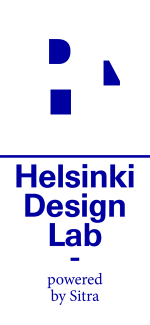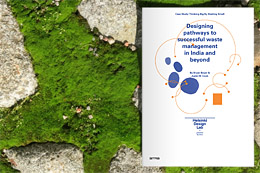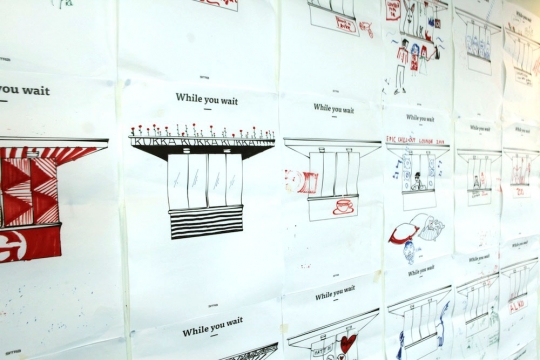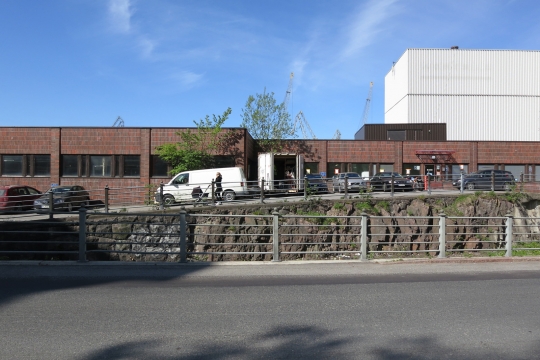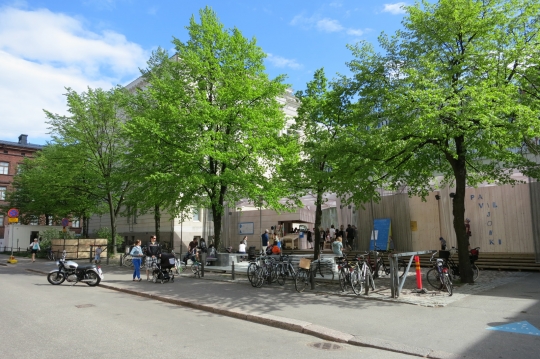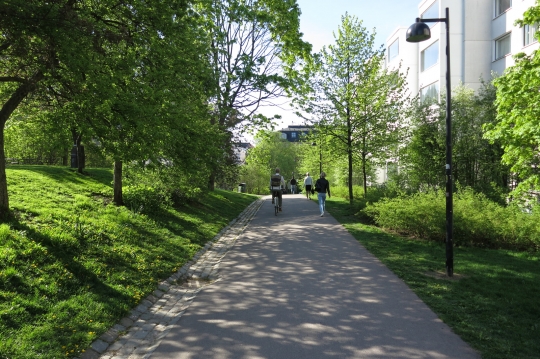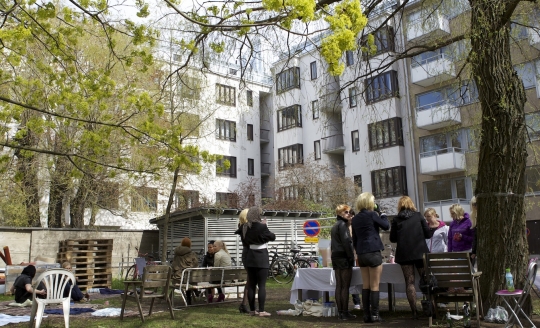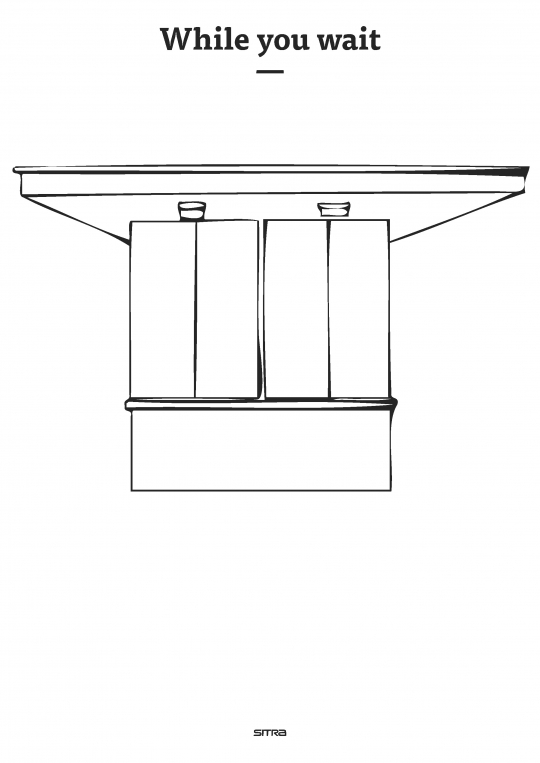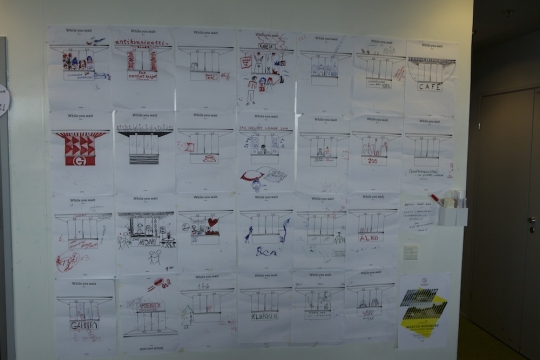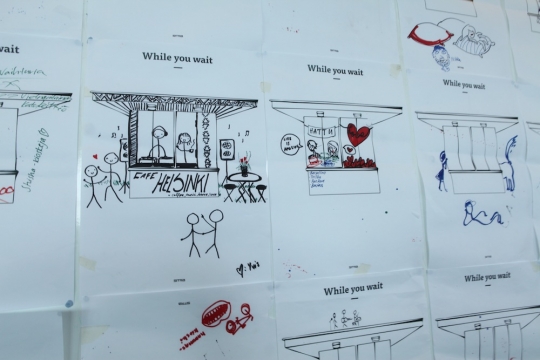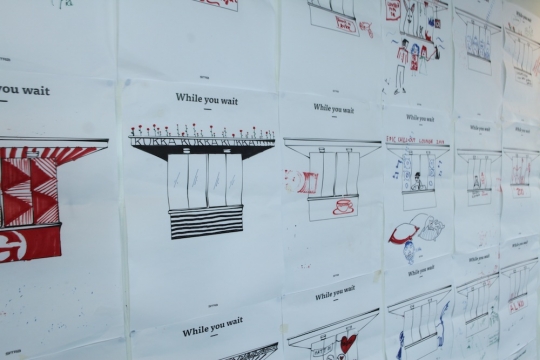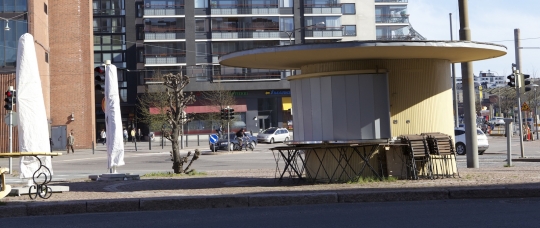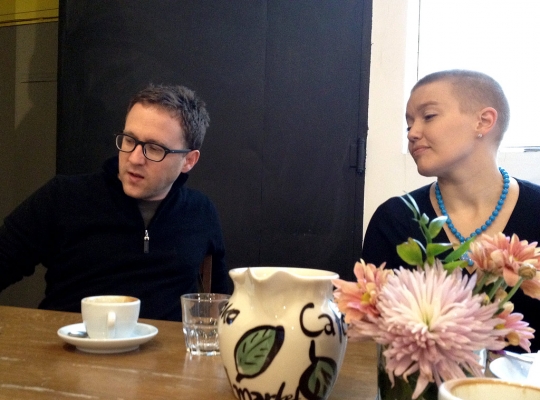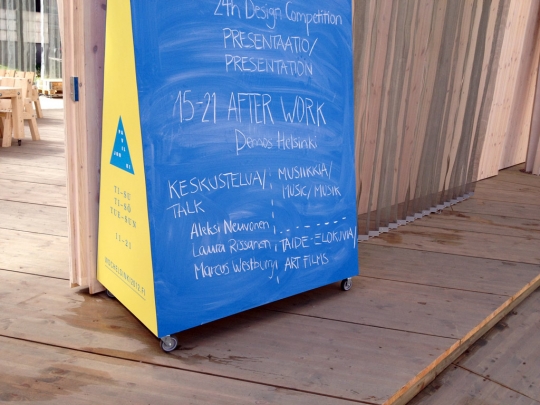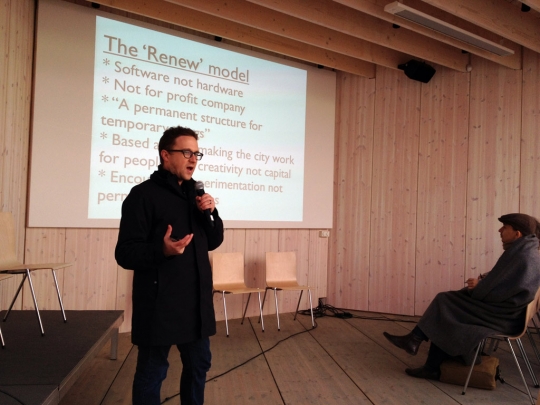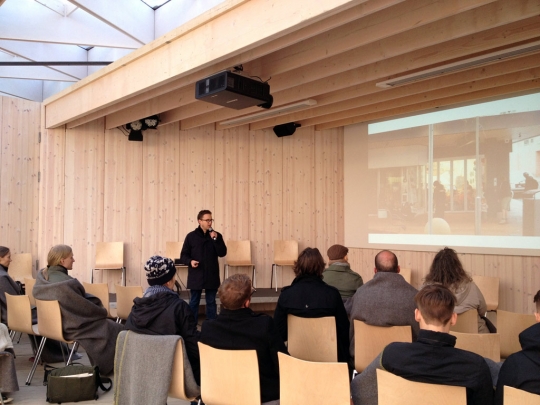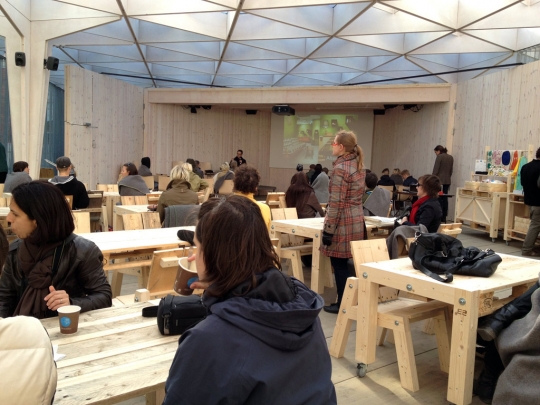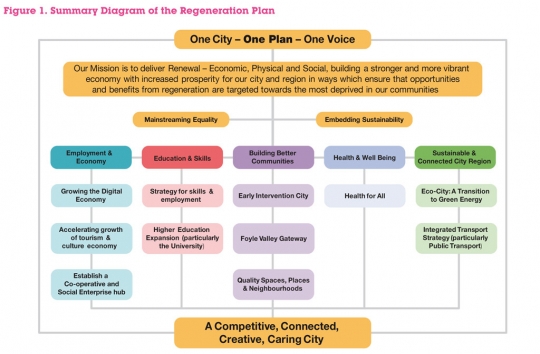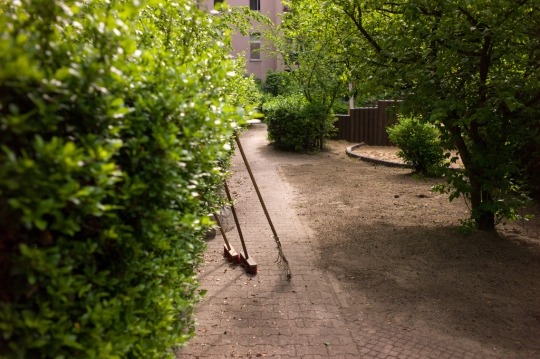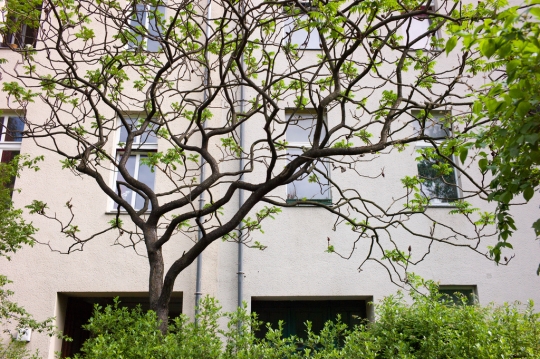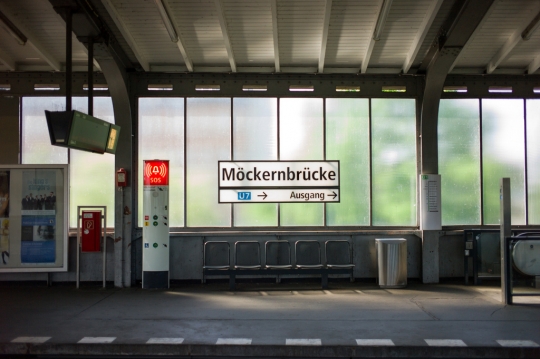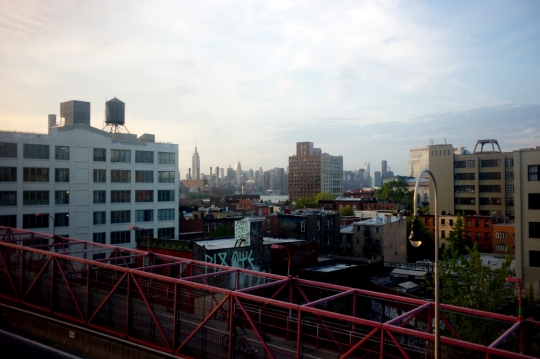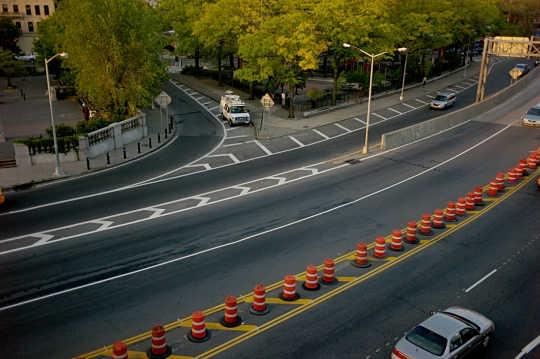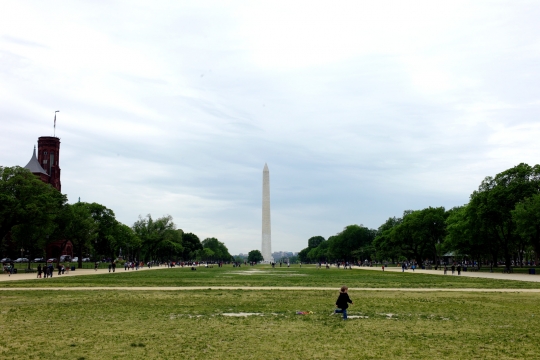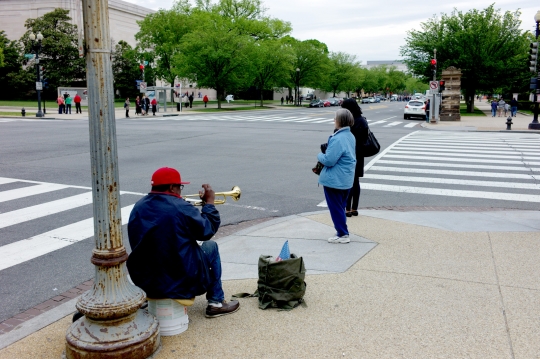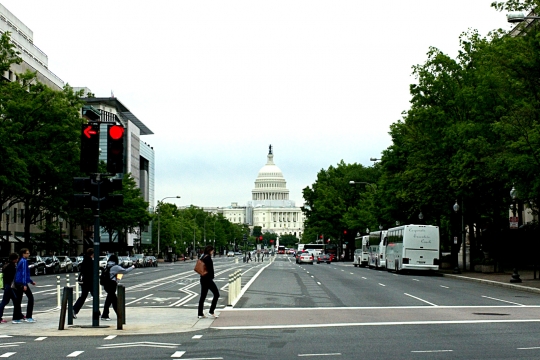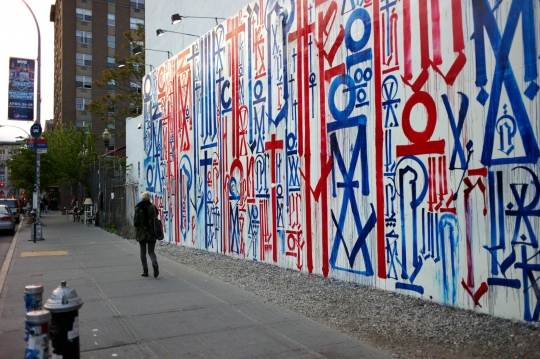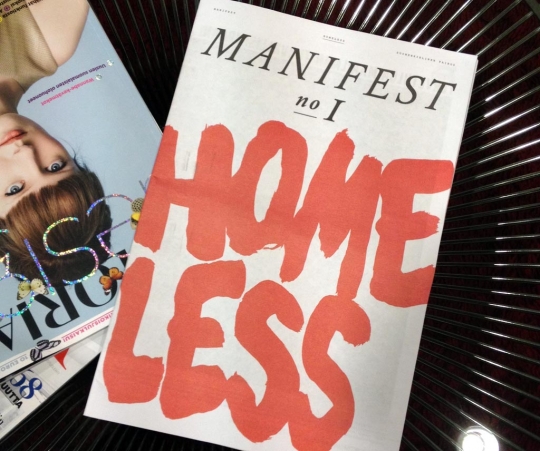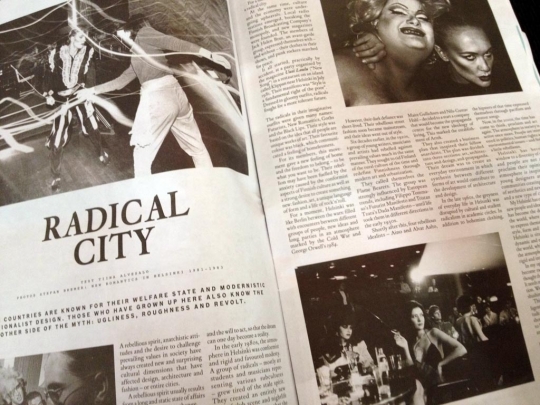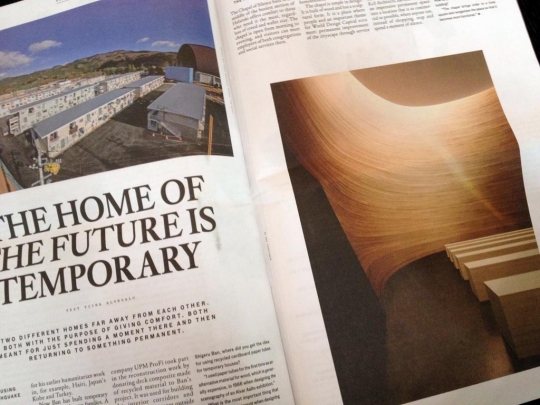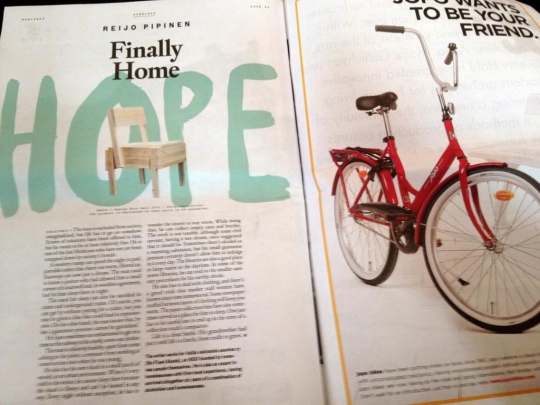Helsinki Design Lab helps government leaders see the "architecture of problems." We assist decision-makers to view challenges from a big-picture perspective, and provide guidance toward more complete solutions that consider all aspects of a problem. Our mission is to advance this way of working—we call it strategic design.
When a weeknote stretches to two weeks, we're flat out. This is a two-week-note. Marco's in Chicago with the mayor, Dan's in Milan giving a lecture at the Politecnico, and Justin's about to board a plane bound for Finland. In Helsinki, Kalle is with the Sitra gardening club planting herbs on the roof of the Sitra tower and I'm here, in my chair, typing this for you.
The Cumulus conference bought a torrent of design educators to town, old and new friends both. We enjoyed seeing Liz Danzico again, a prolific designer, author, educator, and tourer-of-Helsinki. Mariana Amatullo was visiting from Art Center in Pasadena, California where is the director of the Designmatters department. She spent a day and a half doing research for her PhD by interviewing stakeholders in our Design Exchange Programme and grilling us with thoughtful questions. Eduardo Staszowski and Lara Penin from Parsons School of Design Strategies dropped by too, and we had a good conversation about the differences between strategic design practice in a place like Finland which has a strong public sector and somewhere like the US which has a more fragmented landscape. Brenton Caffin was here briefly at the beginning of last week too. This is what the World Design Capital year is like.
With learning in the air, one of the things that popped up in each of these conversations was our position on the practice of strategic design and innovation more broadly. We call it legible practice and I've written up those notes in a separate post:
Doing things in the open is not the best way to help them grow. To encourage scale, we must do work in ways that are inviting, easily read, and digestible.
Dan has ben writing too. He has a book out as part of Stelka Press' inaugural series. It's called Dark Matter and Trojan Horses: a strategic design vocabulary and it rather provocatively argues for...
...A new vocabulary of design, one that needs to be smuggled into the upper echelons of power... Increasingly, effective design means engaging with the messy politics – the “dark matter” – taking place above the designer’s head.
If you're in Moscow on June 18th you can hear about this at his public lecture at Stelka.
Brickstarter continues apace. Right now we have a local web shop coding the first clickable mockup. It will be viewable on the Brickstarter website in due time, but not just yet. We're also reading, reflecting, and interviewing existing projects about their experiences with self-initiated development.
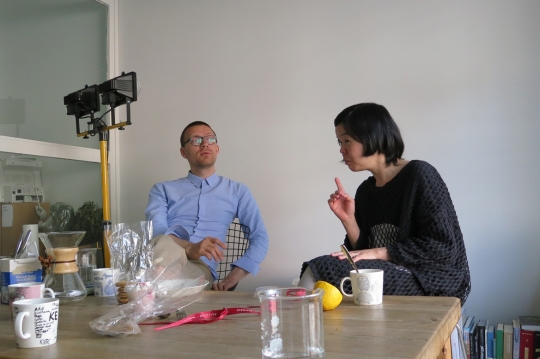
Tuomas Toivonen and Nene Tsuboi telling the tale of their Kulttuurisauna in Merihaka, Helsinki.
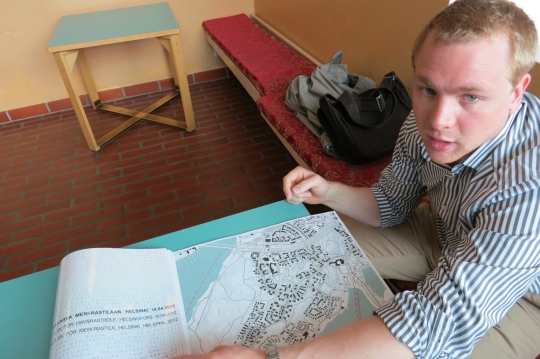
Tristan Hughes explaining a community-developed alternative masterplan proposal for Meri-Rastila.
It's basically impossible to get Kalle to stop talking about food, which is a good thing since that's what he's here to do. During the last Ravintolapäivä he operated a pop-up coffee stand which also served as a community idea collection point, resulting in some telling (and often humorous) drawings. Most of his time is spent wading through city webpages, collecting and sorting information about getting a food business off the ground. This will eventually be part of something we're calling This Is Not A Cookbook (a guide to Everything But The Food?) which will be part of the food entrepreneurship bootcamp we're planning for later this year.
I've been on the horn with groups US and Chile, coordinating a meeting for this summer to dig into two case studies for HDL 2012. It's constant logistics on that front at the moment as I attempt to wrangle diaries of 28 people in five time zones across the total of six case studies we're hoping to pull together. To amuse myself, I tinker with the spreadsheet that keeps all of this straight (and on budget). Two words: conditional formatting.
Marco and Justin are both 110% on Low2No at the moment as some critical decisions get made. On a much smaller scale, we had a few triage meetings about the renovation project that's ongoing in the current Sitra tower. Finland shuts down for all of July, which is a wonderful and maddening fact of the way of life here. This wreaks a special kind of havoc on production timelines and there was some danger that our 12th floor renovation would get pushed until after summer. After some decisive action I think we've narrowly managed to avoid that delay, and we're still currently on track to have the new spaces by August. Hyvää.

Left: the existing space. Right: after basic demolition. Renovation has begun.
Then this happened:
The city has exploded into greens and blossoms as the trees come back to life, dusk and dawn melting into a continuum of tarry daylight. Welcome, summer.
During the past week or so we've been hosted visitors from three continents who are curious about strategic design at Sitra. In each of these discussions we've touched on something that we call "legible practice". I first used the term on this blog less than a year ago, but it worked its way into our daily vocabulary somewhat before that. We use it as a way to split hairs with all the hype around "openness". Open data, open innovation, etc.
At risk of sounding arch, "legibility" has become a core notion of how we think about innovation, or perhaps more specifically public innovation, and this post is an attempt to define the term and describe its value. Very simply, doing things in the open is not the best way to help them grow. To encourage scale, we must do work in ways that are inviting, easily read, and digestible.
Let's hop back to 1994.
The world wide web used to be a very different place. Much of what's available on this website was not possible twenty-some years ago. Few people knew how to make websites in 1994, and there were certainly no schools graduating students who were versed in the subject. Most people learned like I did, from a friend who taught them the basics of HTML and showed them the most important command in the history of the internet: view source.
"View Source" is a command that lets you see the code that makes a webpage work. This is unique to the web—your word processor, for instance, does not allow you to see the source code that makes it tick. That's proprietary code (unless it's open source).
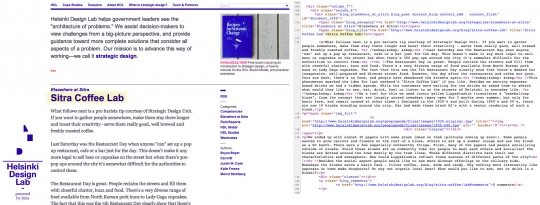
Left: our website. Right: a portion of the code you will see if you view source. I've highlighted a bit of text in both so you can see how one connects to the other.
But the ability to see the web page and the code that manifests it has been built into web browsers since the early days, and liberal use of the command is an invaluable tool for self-learning. HTML is a simple language, so as long as one can access the source code they can usually 'read' it without too much pain. I don't know why someone decided to add "view source" as a feature of the web browser, but it facilitated the spread of knowledge about how to make web pages. Here we unearth the imperative for legible practice.
Not only was the web new and rapidly evolving, but since there was not an in-built stock of Web Experts the group of people who happened to find themselves as members of a community building the web—and simultaneously learning how to build it—were all coming from different backgrounds. A lot of them were computer scientists, but there were also bored architects, distracted social scientists, news junkies, eager business students, and probably more than a few video gamers. The sheer diversity of the community meant that tropes and models from any particular tradition of knowledge could not be relied upon. Tutorials and other learning resources tended towards a more general audience because the community itself was more general in composition. The knowledge base and the community were in flux.
Innovation is in a similar moment of rapid development. The View-source paradigm implies that the more a developing practice enables and supports self-learning, the quicker it can grow and spread despite having a diverse composition. If you want something to go viral, you have to think about how it spreads. Practices tend to be a fair bit more dry than your average animated gif meme, so those of us who are invested in spreading a way of working have to think extra carefully about how they spread. We try to bring this concern into the core of our work.
As a public institution we enjoy the ability to do just about everything in the open, free for others to pick up and build upon. This comes in small gestures, like making our publications available under a Creative Commons Share-Alike license, but openness is not enough. As we aspire to maintain a legible practice, we're in the habit of not just sharing our work, but sharing how and why we do things in a particular way.
To invoke a bit of an infinite loop, this post is an example of what I'm describing, as are the rest of the how-tos. And we're not alone. Friends at Government Digital Services in the UK are conducting their own legible practice, and we would be happy to have other examples posted as comments below.
Other examples include our book In Studio, which features documentation of three studios we hosted side-by-side with a thorough how-to; full documentation of the Low2No competition including brief, process, and outcomes; and the Brickstarter project blog, where we're documenting every aspect of the project's development.
In each instance we are attempting to take a step back from the work itself and describe how we approached the problem as well as the methods, tools, or techniques we used to address it. We do this as an invitation to engage in a discussion about the work and its practices. In an ideal world, everything we produce would come with a "view source" regardless of medium.
The reason that we invest time in sharing in a legible way is twofold. Primarily, we feel that it's important to reflect upon the practices that we're developing, especially at a moment like this where knowledge is productively fluid. Doing so helps us hone our skills. It makes us smarter. Second, making our work legible enhances the likelihood that it will be copied.
An innovation fund is only as useful as it's innovations are influential. And what better way to be influential than to be as easy to copy and build upon as possible? Besides, when we see someone pick up a bit of our work and use it in their own way, we benefit by having our thinking reflected back to us in new ways. When describing practices, that reflecting-back is exactly what scale looks like.
What follows next is a pro barista tip courtesy of Strategic Design Unit. If you want to gather people somewhere, make them stay there longer and boost their creativity - serve them really good, well brewed and freshly roasted coffee.
Last Saturday was the Ravintolapäivä ( "Restaurant Day" ) when anyone "can" set up a pop up restaurant, cafe or a bar just for that one great day. People reclaim the streets and fill them with cheerful chatter, buzz and food. There's a very diverse range of food available from North Korean pork buns to Lady Gaga cupcakes. The fact that this was the 5th Restaurant Day clearly show that there's demand for inexpensive, well-prepared and diverse street food. However, the day after the restaurants and cafes are gone. Cars are back, there's no food, and people have abandoned the streets again.
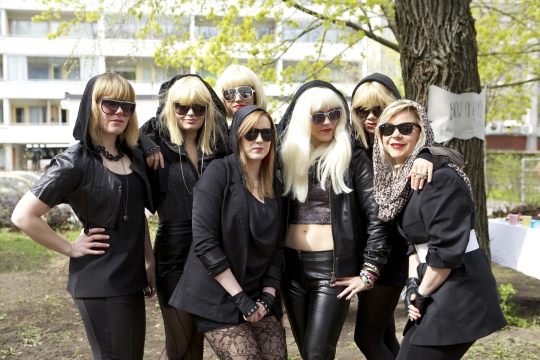
Lady Gagas running a cup cake pop up.
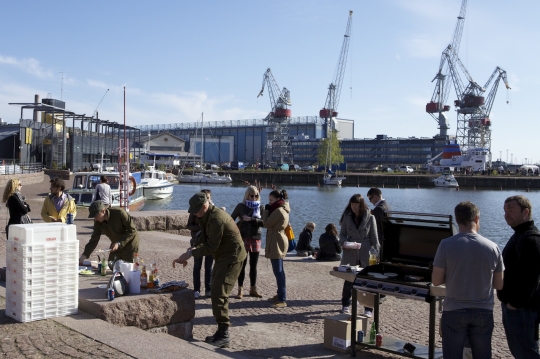
North Korean miso salmon and pork buns by the sea.
This phenomenon sparked the idea for last weekend's "Sitra Coffee Lab" if you like. Besides me serving espresso based drinks we had a hidden agenda. While the customers were waiting for the drinks we asked them to sketch what would they like to see, eat, drink, feel or listen to on the streets of Helsinki in everyday life.
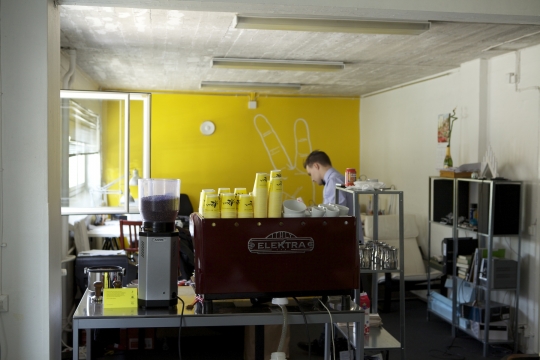
Serving coffee from the window of a co-working space on Hietalahdenkatu.
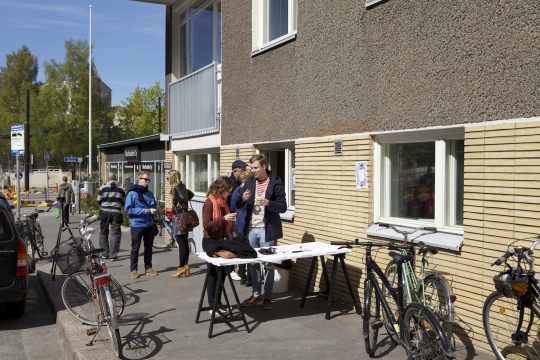
People waiting for their coffee.
As a tool for this we used iconic yellow Lippakioskis (in Finnish) (translates a "baseballcap kiosk", from the canopy) that are largely unused nowadays (many open for 3 months over summer, but only for basic fare, and remain unused at other times.) Designed in the 1930's and built during 1940's and 50's, there are now 19 kiosks standing around the city. Dan had made these blank A3's with a vector rendering of such a kiosk.
We ended up with almost 30 papers with some great ideas on them. Some people wanted to grow carrots and flowers on the roof of a kiosk, others to set up a summer lounge and use the kiosk as a DJ booth. There were a few especially noteworthy things. First, many of the papers had people socializing outside of kiosks. Could these kiosks act as community hubs for people to meet each others and socialize? The kiosks are dotted around the town mostly by the tram lines. These different districts have their own characteristics and atmosphere. How could Lippakioskis reflect those nuances of different parts of the city, just like they do in Käpylä and Kallio?
Besides the social aspect people would like to see more diverse offerings on the culinary side. Nowadays the kiosks serve, as mentioned ealier, just a basic fare - filter coffee, buns, soda and candy. Why nothing more interesting like espresso or home made doughnuts? Or why not organic local beer? What would you like to see, eat or drink in a Kioski?
Hello, it's me again, and so predictably this is a few days late.
Before I run through last week's events, I thought I'd share this. Bryan tweeted a Dezeen article about the new Shard tower in London—an interview with the lead architect, Renzo Piano—noting in particular the usefully low car parking provision. There are 87 floors in The Shard, 72 of which are habitable, and it has 47 parking spaces, essentially to cover the requirements of disabled people, according to Piano.
Having worked on a few so-called sustainable developments in my time (admittedly mostly in car-dominated Australian cities) this is extraordinarily impressive. Piano also notes that the direction here came from Mayor Ken Livingstone, which is also impressive—politicians driving that number down is rare; usually they're in a defensive mode, worried about their constituents (often underestimating their constituents' own ability to change, actually) and pushing back against the design teams.
Here in Helsinki, every day we look out onto Jätkäsaari, which is one of the city's strategic sites for sustainable development. A typical block there will be designed to have around 7 floors and have to make space for approximately 120 parking spaces. Both cities are well-served by public transport (in fact, Helsinki has previously been voted as having the best public transport in Europe) and Helsinki being a compact city, you could walk to most bits of central Helsinki from Jätkäsaari. This quite different parking ratio here is also directed by the city council, of course.
This disparity seemed so ludicrous I had to draw it. First, the two developments: The Shard at 87 floors, and 47 parking spaces; a new "sustainable" development in Helsinki's Jätkäsaari has 7 floors, and 120 parking spaces:

Parking spaces for The Shard tower, London versus parking spaces for Jätkäsaari sustainable development, Helsinki.
To put it another way, the ratio for The Shard is around 0.5 parking spaces per floor, whereas Jätkäsaari's ratio is around 17 spaces per floor. What if you applied the ratio for The Shard to Jätkäsaari and vice versa?
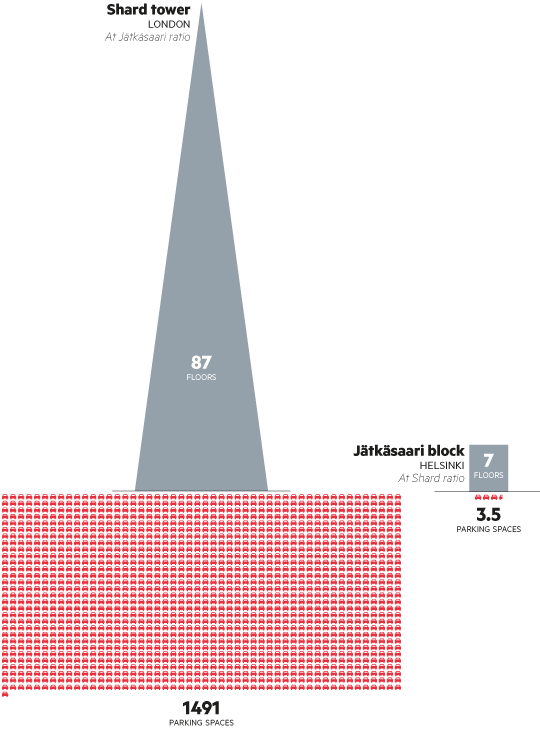
Parking ratio for Jätkäsaari block applied to Shard tower, and vice versa
Thought for the day.
Anyway, last week's thoughts had a big public holiday-shaped hole in them on Thursday, but the rest of the week was full of life.
I was knee-deep in designing Brickstarter mock-ups—more on that soon, but some old sketches are now up at brickstarter.org—and working with the Sitra management team on our new working patterns, workspaces and so on. Kalle was researching street food legislation in global cities, roaming (via the web) from Portland to Stockholm.
Meetings-wise, I had time for a poor cup of coffee but a good chat with Melinda Sipos, a Hungarian designer/artist whose provenance includes the seemingly excellent Kitchen Budapest. I met up with web developer Ville Kolehmaimen from Fusion Inc, had lunch with our own Pekka Salmi to discuss what we (Sitra) might research around crowdfunding legislation in Finland, and Kali Auvinen and I had a fascinating Brickstarter-related conversation RE NIMBYism and sustainable development with the chairman of the Finnish wind power association.
Meanwhile, Bryan was in the USA for an equally full week, culminating with a panel at the inspiring Studio-X NYC (run by our chums Geoff Manaugh and Nicola Twilley) which centred around the future of design practice in a plural, political world. He also was part of a panel at WantedDesign about the possibility of entrepreneurial design to sketch out new cultural possibilities, including +Pool, Brickstarter, and games that reveal the richness of the spectrum of possible social interactions. In between he was meeting and on the phone to line things up for HDL 2012.
Working across the Helsinki-Boston axis, Marco and Justin were embroiled in the usual intense stewardship required by our Low2No project.
Meanwhile, back in Helsinki, by the end of the week we were privileged to have Marcus Westbury of Renew Newcastle/Renew Newcastle fame in town. Marcus is an old colleague and friend from Australia, and we took advantage of him visiting London to bring him across to Helsinki for a couple of talks, as part of our Brickstarter research (for more on Marcus's work in this context, read the notes from this discussion we had a few months back, or this old post on "emergent urbanism" from my blog a few years ago.)
As those notes describe the general area I won't go into the ideas again here, suffice to say Marcus did a great talk for Sitra colleagues over lunch ...
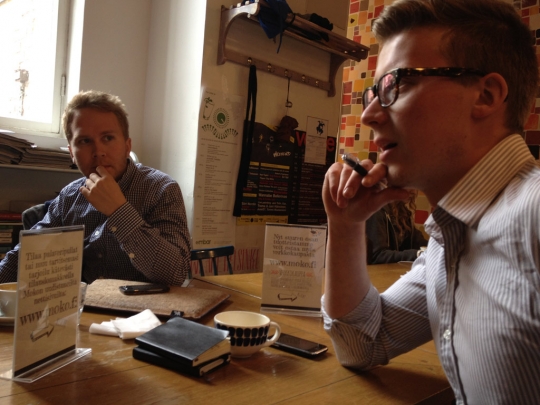
Kalle asks a question while Kalle looks on
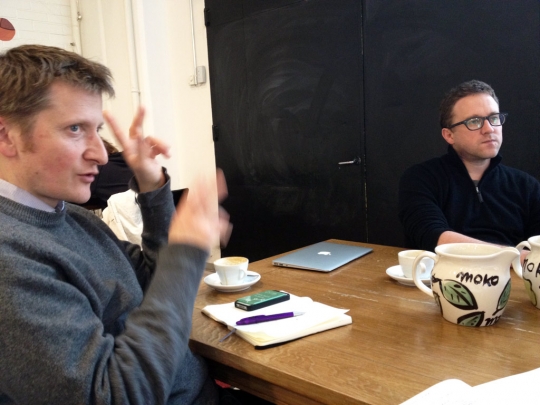
Marco reveals his Italian heritage
... And then Marcus repeated the feat for a public audience at a Demos Helsinki-curated "City 2.0" event at the World Design Capital Pavilion on Friday night.
Although it was so chilly that the pavilion felt like a wooden memorial to optimism, we had a good crowd of 40 to 50 or so (thanks!) and a good discussion after too.
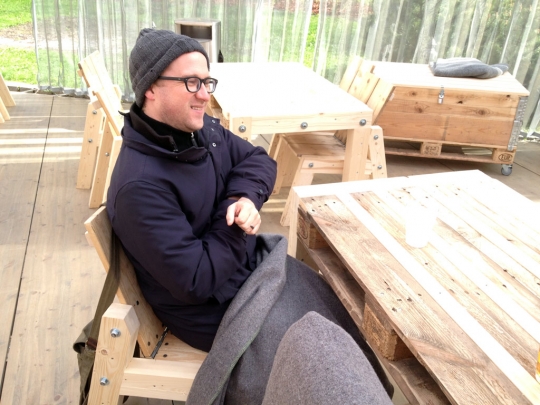
An Australian suffering the Helsinki spring.

Finns suffering the Helsinki spring.

Marcus's talk generated a good Q+A, including discussion of similar projects here in Helsinki.
Thanks to Marcus for coming over, and sharing his numerous insights, and thanks also to Tommi and the Demos crew.
Fortuitously, the following Saturday was Ravintolapäivä, Helsinki's festival of pop-up restaurants, and so I was able to walk Marcus around that too. This was in no way a hardship—it was the city at its best—and easy on the stomach too. Ravintolapäivä demonstrates a different kind of urban activism to Renew, but they're derived from similar instincts: creating a framework for encouraging everyday experimentation within the city. Saturday also demonstrated to Marcus that spring in Helsinki can be warm.
I've written all that up over at City of Sound, so do have a read over there if you want to learn more about the wondrous event that is Ravintolapäivä aka Restaurant Day, and what it might mean for cities like Helsinki. While you're there, note the use of Kalle's coffee stall as a honey-pot for design research—more on that soon from Kalle.
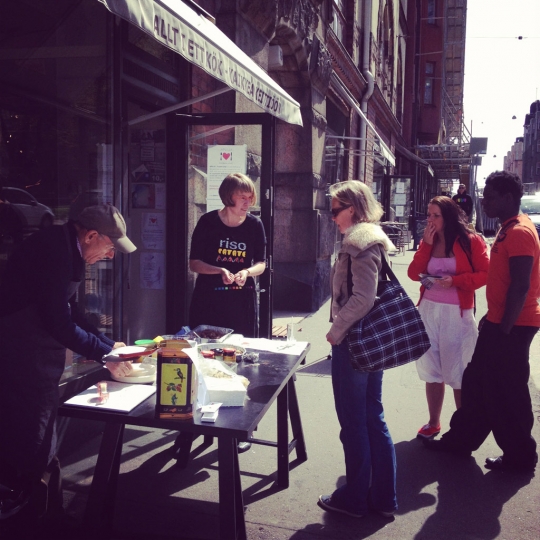
Ravintolapäivä is wonderful. Here, gourmet Italian food on the street.
As Dan already mentioned in his previous post, I just recently started here at the Strategic Design Unit as an intern. Currently I'm studying marketing at the University of Helsinki's Viikki campus. While telling people I'm a marketing student almost all of them reply "Marketing - at the Aalto University School of Economics, right?" The difference is that in Viikki we focus and specialize in understanding the marketing needs of the food industry and other players on the edible field whereas at Aalto it's purely marketing itself. I'm also doing a minor consisting of all kinds of food related subjects - a little bit of chemistry, logistics and so on.
The first weeks at Sitra has been very interesting and exciting - never before have I had a desk of my own and a view from the 14th floor, overseeing the beautiful seafront and archipelago of Helsinki and Espoo.
Being a barista, the first project I assigned to myself was to think of a better solution for the office coffee. Also, I've read at least a dozen articles and papers regarding the Helsinki Street Eats project.
Recently +Studio, a "design accelerator" and co-working space in the creative Punavuori district of Helsinki, held a breakfast session titled as the New Visions for Food. Futures specialist Ville Tikka, who also contributed to the Helsinki Street Eats book, from Wevolve agency presented his idea on how the food systems might change in the future. The linear value chain from farm to fork is likely (and already has in some cases) to transform into a network of functions interconnected to each other.
That concept will surely hover around the Street Eats project which is the one that I'll be working most with. We'll be taking a close look to street food in Helsinki and hopefully finding new ways to develop it. In addition to all things food related, I'll be helping out with Brickstarter as well as HDL 2012, as that shapes up.
During the first few weeks here at Sitra I've met so many interesting people. I'm very excited to start working with all these professionals and to really get my hands on the various projects at hand.
OK, latenote for last week. The highlight was perhaps a great conversation with various representatives of Canada's Social Innovation Generation partnership (SIG), who were in the neighbourhood (well, Stockholm) and were kind enough to swing by Helsinki for a chat.
They're doing really interesting work scoping out what they call the "change lab" model, preparing the ground in Canada. We were visited by Cheryl Rose (Associate Director of Waterloo Institute for Social Resilence and Director, Program Development for SIG), Tim Brodhead, (JW McConnel Family Foundation, SIG, MaRS Discovery District), and Sam Laban (Education Program Manager, SIG). We have lots of visitors to Sitra and HDL, and always enjoy and learn from the discussions and connections, but rarely has a group been so well-prepared and asked such perceptive and insightful questions.
I'm intrigued by Canada, having never been but idly marking it as a kind of mirror/inverse of Australia (vast, sparsely-populated, resource-rich, echoes of empire, Anglo in bits, fine cities, incredible landscape, great cities etc. etc.—and it is of course completely different, I'm sure). And we've been delighted to see the thinking emerging there—as noted previously, their summary of lab-like iniatives ("Labs: Designing the Future") is definitely worth a read—and so we're really pleased to open up this diaglogue. It looks like I'll be visiting Canada in return, this November, which I'll update you about nearer the time. Thanks to Cheryl, Tim and Sam for popping in.
Bryan had to rush off after lunch with the Canadians, heading over to Derry. After noting the preponderance of wind turbines in the Irish countryside ...
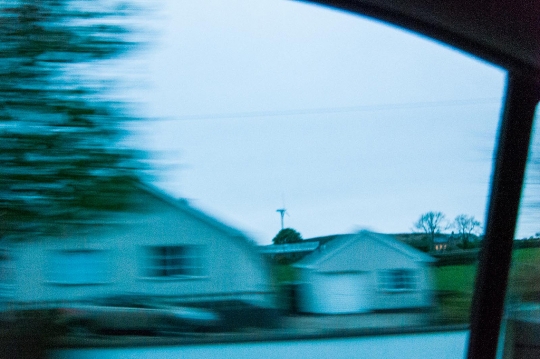
Turbines in the Irish countryside.
... he took part in the Academy of Urbanism's Annual Congress on The Resilient City, and he reports that It Was Good. The level of conversation was excellent, and the very particular context of Northern Ireland perhaps lent the affair a seriousness and motivation that is often lacking in similar events.
Bryan pointed me at one project—a comprehensive regeneration plan for Derry-Londonderry [read the full PDF or summary PDF]. It looks to have a good strategic edge, which foregrounds what I'd call the real drivers of cities (economy, culture, community) but views them holistically alongside some necessary strategic interventions (improving health, approaching sustainability) and then draws in secondary or tertiary matters like infrastruture, buildings and so on. Have a squint at the diagrams on page 7 and 8 of the shorter PDF:
Meanwhile, lots of work on Brickstarter. I've started designing the first 'alpha' version of the web service, which we'll share some details of shortly. As ever, we're using the website as a kind of token in order to open up wider, systemic issues—but you have to build the thing in order to flush them out. So it's been very interesting, and very rewarding, to finally be discussing the details of the various interactions we want to explore i.e. crowdfunding versus voting? What do we mean by voting? How do we balance a democratic model alongside crowdfunding? How explicit do we make the council? How to do a slow reveal on the dark matter so as to enable a low barrier to entry yet subtly unpack it over time such that the project proposals are robust enough to be taken seriously? All this and more emerging over at brickstarter.org shortly.
I love getting to this stage of a project, as everything starts to come together. With a project straddling governance and democratic models, crowdfunding and emergent community actions, sustainable development across use of shared space, shared resources, energy and so on, it actually helps crystallise the project considerably. Then our job is to draw out the shifts in this otherwise imperceptible dark matter implied by such a product or service, such that we might enable their productive reshaping. (I also happen to love spending hours in Photoshop and Illustrator, frankly. For the strategic designer, the challenge is always to balance the lure of exercising your craft skills with the requirements of the strategic, systemic view. But one enables a better view of the other, and vice versa.)
We finally got our first Finnish post up there (thanks to Kali!) and there's a good overview of crowdfunding platforms by Bryan, too.
Kalle's been doing some nice background research on 'food profiles' for other cities, for Helsinki Street Eats. We'll have a set of cards emerging for different cities shortly, to enable productive comparison with Sydney, looking at the regulations, governance culture, scene on the streets, and so on. We're also now in discussions about how and what we can fund in this area—more on that shortly.
I've also been helping out with the organisation's imminent reorganisation in our building. With Bryan, we've been leading a renovation of one of the floors, but again, really we're looking at the organisation's culture, the way we work, and interract, and so on. (Again, the balance of crafting a specific output with the wider strategic, cultural view.) We have a 'bootcamp' with the management team next week to draw up the first sketch of a new organisation.
And two good lunches. First, Bryan and I with Artek's Ville Kokkonen (design director) and Anna Vartiainen (marketing director). Artek are one of the genuinely great Finnish brands and operations, founded by Aino and Alvar Aalto (a bit of background). Their 2nd Cycle concept is a particular favourite in the Sitra office, indicating a form of "resilence" in which the firm buys back its own products and re-sells them, a simple concept that gracefully indicates the ongoing value of good design and production, as opposed to "throwawayism".
Secondly, I had a good catch-up with Tommi Laitio of the powerhouse that is Demos Helsinki, covering many topics: Baana, Brickstarter and beyond. In particular, we discussed the forthcoming event that Demos are curating at the World Design Capital pavilion (or "paviljonki" as it's known here), where we've invited Marcus Westbury of Renew Newcastle/Renew Australia fame to speak, on an afternoon/early evening session about urban development dubbed "City 2.0" (read a previous conversation with Marcus here.) More info on Facebook, and if you're in town, do come on down. (By the way, a tilt-shift time-lapse of the WDC Pavilion going up. It's designed at Aalto University's Wood Program.)
Oh, and it's the Helsinki-originated increasingly global sensation that is Ravntolapäivä (Restaurant Day) this weekend (May 19th) (for background, read our "Helsinki Street Eats" book-let). Make sure you visit Kalle's coffee stall—"Gaffebaari"—in particular!
Finally, some quick linkage: Brickstarter was mentioned in another scene-surveying post about crowdfunding urban development, this time at ArchDaily; John Thackara asks whether we need an Arne Jacobsen of urban food systems, and "Making Planning Popular: A Manifesto" (related to "Sub-Plan".)
And a little more controversially, an interesting take-down of the open data and transparency movements and a reaction to the perceived over-spending on buildings and infrastructure in Valencia, Spain, homing in on Santiaga Calatrava. Sadly, there's little public controvery here about the proposed (or is it?) road tunnel under central Helsinki, which is apparently still sitting on the city's plans somewhere, and has been for years—or is at least alive in the minds of the current generation of city planners. Not only is this a ridiculously outdated idea ("sell by" circa 1970) it is apparently preventing or otherwise hindering other projects from happening. The local media is asleep at the wheel on such matters, as far as we can tell. More here if/when we get it.
Oh, and I forgot to report: Vappu, a couple of weeks back, was a blast. Very special indeed, and no way near as bacchanalian as I had been led to believe (caveat: I went to bed early.)
What we learned in #163 is that Berlin has jumped straight to summer while Helsinki is taking its time with spring. A quick update to keep up the tempo, but not as much depth as usual because Dan and I are hosting a visit from the MaRS / WISIR / SIG in about 3 minutes! Edit: I did not make it, so this is being completed after a very good conversation with the Canadians, but you'll have to wait till next week to hear about that one.
In Week 163 Dan, Kali, and I were in Berlin to do some research for Brickstarter looking into the ways that people are working on community engagement and energy infrastructure. Separate things but deeply related, as we suspected, and as we found.
Perhaps surprisingly, amongst the many threads that tied these two together was the role of narrative. As Anna Poblocka of Eclareon put it, Germany's ability to create a narrative around the move towards renewable energy is an important part of their ability to aggressively pursue this transformation. The next day Dieter Genske expanded this notion by introducing us to the linguistics of this particular narrative which is called energiewende in German.
Use of the word "wende" connects the renewables effort with the importance and scale of another significant act, the reunification of Germany after the wall came down. This is an example of the way that we talk about a specific change helps prime conversation to be positive or negative, empowering or overwhelming, one that preferences the status quo as immutable or sees it as merely a current-state. And while linguistics is a soft topic in comparison to the significant rigidity of (current) energy infrastructure, it's a powerful bit of soft stuff. Narrative is the connective tissue of systemic change.
The Finnish experience maps onto Dieter's point very well, but in reverse. Whereas Germany has created a narrative of change-by-renewable-energy, big decisions about Finland's energy future two years ago relied on narratives of past success to rouse political will in support of maintaining nuclear and propping up traditional industries such as pulp and paper manufacturing. Today, small scale energy production in Finland is stymied by the overhead of permitting, which is designed for nuclear-scale plants, and a limited community of willing investors.
The way Robert Brückmann of Eclareon explained the German experience to date, Merkel's narrative worked in parallel with opportunities that could be acted on directly by individuals and communities. Well-designed feed-in tariffs made renewable energy a safe investment that has snowballed as more people take advantage of the opportunities in the marketplace. After two days of discussion around the growth of renewable energy I began to imagine in my head the German case as an Olympics logo of interlocking virtuous cycles: narrative and discrete opportunity, government and market, individual and community, environment and economic development, short term gain and long term security.
More on all of this in a future Brickstarter.org post but we came back from Germany with new insights into the importance of combined action on the level of large-scale cultural debate and discussion paired with discrete and delicate tinkering within the dark matter of our institutions.
Taking these findings up a level of abstraction and mapping it onto our work in Helsinki, we want to understand cultures of decision making better so that we can pursue innovation from two angles: first, by inflecting public debate towards a perspective of shared-value and shared decisions. Second, by de-risking innovative acts on an individual level.
Internally we joke about this as the glue and the tiny hammer. We're searching for ways to glue together things that have been silo'd or separated, and for ways to carefully begin to crack into big, opaque boxes (like most institutions).
While in Berlin Deiter shared his insights during a walking tour of his own neighborhood. Dan wrote it up on his site. How does he find the time to do that so thoroughly?
As a last note for Berlin, we also had a good visit with Neighborhood Labs which one of us will write up soon for the Brickstarter site. It was a compact but excellent excursion.

One of Neighborhood Labs' findings is that workshops garner a better turnout when waffles are on offer. That's a tactic I can support. Source: Neighborhood-Labs.org
Brickstarter is making its way into the wider world as well: a post at Design Observer that has a good conversation going in the comments and there's another one on the Atlantic Cities blog. We're very happy to see the discussion spreading bit by bit. More of this, please!
Quick hits:
Mike Monteiro recently wrote a good book for designers entitled Design Is A Job. It's geared for web designers, mostly, but relevant for others too. Actually, it's a useful book for anyone who is uncomfortable dealing with contracts, lawyers, management, and other business basics in the context of practice which is as much qualitative as it is quantitative.
On the other side of the Atlantic, the NYT graphics team have set up a blog that reveals their process behind some of the graphics featured in the paper and online.
This side of the Atlantic, The London Olympics have gone a bit appallingly off the deep end in an attempt to keep their sponsors happy.
Lingering in London, MindLab and Nesta have recently concluded a three month collaboration which yielded, amongst other things, a nice little video about the work they did together.
Since the audio's a bit hard to hear, a snippet from Philip Colligan:
I think we should design all public services with people, not do public service to people. So it's about changing the way we think about delivering outcomes. Not about professionals giving service to people, but defining outcomes with people, and using all the resources available to us to deliver those outcomes.
And finally, it's not often that we have the wherewithal to post here before an event happens, but we do have two events coming up next week.
Friday May 18th: Marcus Westbury, of Renew Australia fame, will be here in Helsinki to give a public talk about his work revitalizing disused parts of the city. Dan has been putting this together with Tommi Laitio of Demos. Details are on Facebook. I'm shattered to miss it, but I expect to hear all about it via Twitter.
Saturday May 19th: I will be in New York to take part in New Finnish Design City, an ICFF satellite event. Friends of HDL Q&A are curating three days of panel discussions and workshops which you can read about here. I'll be sharing a panel with Dong-Ping Wong and Colleen Macklin about using design to framing the right questions.
And in honor of Maurice Sendak who passed away this week: Goodnight, Week 163.
As I return to Finland after some time in the US I'm writing in the sky, but not skywriting. Does seem like fun though, to fly in big broad strokes and puff-puff-puff slogans out of smoke with the horizon as a metric. We are not doing that aboard AY006 from JFK to HEL. Nothing but strong tailwinds and a full laptop battery.
I've been on the east coast of the US, mostly in NYC and Washington, DC. In New York my time was spent talking to groups like the +Pool folks and trying to understand how community projects take advantage of online fora. More about that on the Brickstarter project page, as Dan mentioned previously.
I've also been meeting new people, which is always nice. First was Hilary Hoeber, Senior Portfolio Lead of public sector work at IDEO. Over the past few years one of the questions we've been grappling with is whether or not there's a viable role for consultants in bringing design to the public sector in the long term. This might sound like a crazy question, but a challenge that all organizations struggle with, and particularly public bodies, is to execute on the good ideas that they have.
The "give and go" stereotype of consultancy leaves the clients to muddle through execution of ideas that well-paid-someones drop on their desk. Stewardship is part of the design process, which can make design consultancy a tricky thing. IDEO are concerned about this 'delivery gap', and have been helping their clients close the gap pairing project work with organizational coaching and transformation efforts as a way to address the issue. More on IDEO's public sector projects in Metropolis Magazine.
There's a similarity here to our Design Exchange Programme. As we place designers into public sector organizations we're essentially creating a context where the org and their new designer can work together for a year to both deliver a discrete project, but also begin the slower and more fundamental work of opening up to new cultures (on both sides) and translating or exchanging ways of working through the medium of a discrete project collaboration.
Beneath the clattering deck of the Brooklyn Bridge I met Chelsea Mauldin, who is Executive Director of the Public Policy Lab, to learn about the developments of public sector service design in the US. Her organization hosts a number of fellowships that enable designers to allocate part of their time to work for different city departments and agencies.
Rather than full time placements, these fellowships are part time. Whereas our designers are hired into the host organization as part of their payroll, the PPL fellowships are 'work for hire' provided to the host but paid for by PPL. This is one of the options we debated too, so it will be nice to compare notes with PPL in a year or two and see how the different approaches worked out. The Public Policy Lab is also working with Parsons University to create opportunities for students to be involved in the early stage analysis work. Good stuff.
To round out a hattrick of good people, I bumped into Clay Shirky at a social gathering, who I've met briefly before but never had a chance to properly talk with. I'm a big fan of Clay's extensive writing, so I was quite happy, but this was also auspicious since I had recently listened to a panel that he participated in and I could quiz him about it further. During the Hacking Society panel Clay postulated that in the online world, one-vote-per-person style voting does not really work, and instead the three primary forms of expressing personal desire as part of an online community are:
- Forking: geek for using someone elses' work as a starting point for your own and therefore causing a fork in the history of that thing or idea;
- Collaborative editing: such as Wikipedia where authorship is essentially subsumed by the mash of changes and people making them;
- Karma: which is a way to grant users of a system an increasing level of capabilities/privleges the more they are deemed to be a positive addition to the site, through some combination of patient waiting and constructive commenting.
My gut reaction to Clay's point was to cling to the sacred democratic vote, but with further reflection I'm starting to see his point. The cost of communication online (in time, money, just about every metric) is so much 'cheaper' than it ever has been that online communities tend towards profusion more than scarcity. Our attempts to develop Brickstarter as a tool for 21st century community decision making will take this into account. Dan and I will likely spend some part of the upcoming week debating these points and trying to map whatever conclusions we come up with onto the Brickstarter work.
On that front, he has been working on mockups stemming from the numerous conversations we've had up till now. Good to get the ideas onto paper and I'm happy to let him do the heavy lifting of translating our pile of notebook scribbles into something sensible!
Dan and Kali have been busy while I've been away: Meetings with Finn Williams about recent changes (read: simplified and sane) to the planning legislation in the UK as well as the clear presentation of such; Akseli Tuomisto, a lakimies (literally "law man") with Castrén and Snellman Assocates whose thesis was on different models of wind power development across the nordic region and in Germany; as well as chats with Ossi K. and Karo L. here at Sitra about linking up Brickstarter with their work on open data. This was a week of Dark Matter for Brickstarter.
Marco was deep in Design Management Institute territory as co-chair of their event this past week. Besides making sure the event flowed well, he was also catching up with familiar faces like Darrel Rhea and Christian Bason.
Due to the cruel illogic of logistics, Justin and I switched places. While I was in the US, he was in Amsterdam participating in the 12th European Forum on Eco-Innovation hosted by the European Commission. Low2No was the topic, naturally, and in particular the work that goes into creating an ecosystem of innovation and opportunity around a specific nexus like one single block. From time to time we talk about this as the "trojan horse" approach to policy and market creation, or using projects to prototype policy.

Justin sharing Low2No with the EC. Source: Europa.eu
At the Global Impact Economy Forum in DC Secretary Clinton announced a new partnership that will focus, amongst other things, on making it easier to create sustainable cities, particularly in developing economies. I was there to share our Low2No experience in the context of the question: how do public and private sectors work together to foster shared-value investment in the built environment?
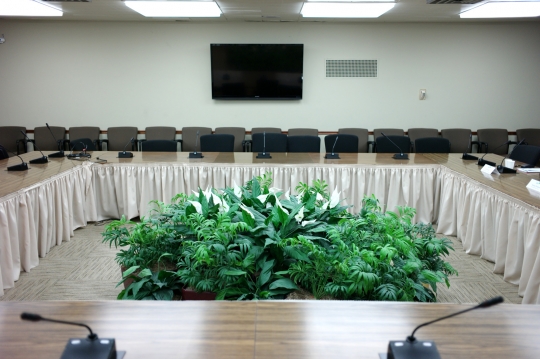
This was the most handsome patch of trapped plants I saw at the State Dept.
David Wood did an excellent job moderating our panel. I was the pipsqueak in a row of heavy-hitters as we compared projects from the block scale of Low2No, up to the entire city of Songdo, South Korea, and then infrastructure efforts of CDG in Morocco. The core of the conversation was summed up well in a comment from a South American government official who will remain nameless, as relayed by fellow panelist Stewart Sarkozy-Banoczy: I can find money to build housing, but how to I deliver all the other aspects that make a thriving community? The traditional capital investment is one thing, but finding the ability to invest in the broader ecosystem of factors that contribute to the ultimate sustainability—or not—of a community is now the challenge.
The approach we're taking with Low2No is to consider the building as situated within a larger spectrum of activities that range from the dark matter work of lobbying for (and co-authoring) new codes & regulations, exploring finacing and operational models, developing programmes to spur low-carbon entrepreneurship and citizenship, and so forth. Coming on almost 4 years into the Low2No experience, we have a pretty solid idea of how to comission and design sustainable urban environments in this interconnected way. Delivery is another slog unto itself, but one that we're happy to be in the middle of at the moment.
It was a solid event that covered a lot of ground, often times deep in the nitty-gritty of finance where I struggled to keep up (my favorite kind). Because I know that the internet loves lists, and I'm not one to disappoint, the messages I kept hearing at the event were:
- Systemic from the start: initiatives should not be done in an ad-hoc way to get them off the ground and then redesigned for scale later. The up-front strategic work should take into account the possibility/mandate of scale from the very beginning and use this as an advantage. In my own words, I would articulate this as "design every platform as a product and every product as a platform"
- Data drives the market: there are still big opportunities for anyone who can provide data (or other comparative mechanisms) that simplifies the task of comparing a variety of options, be it which charity to give money toor which ship to hire for your intercontinental logistics, etc. Jagir Shah gave one potent example: the Carbon War Room began publishing fuel efficiecency data for ships. The availability of this data natrually fed into the exsting data-crunching machines of insurance adjusters and other analysts, effectively raising the price of fuel-inefficient ships. In other words, data doesn't have to be extensive, but it should be operative and useful for the right decisions.
- Collaboration is still hard: building up enough trust to do things differently, to invest in social impact, for example, still takes time. It was encouraging to see many of the world's large banks at the forum to have that kind of scale in the room, but more than anything their participation and movement towards adding social impact products to their suite of offerings is an important act of signaling to the market culture. As we are all making tactical efforts to deliver projects and make deals, we should also acknowledge head-on the broader cultural shifts in risk and trust, and the way that our various cultures of decision-making model these. Multi-disciplinary teams are able to internalize—and appropriately respond to—some degree of these different cultures, giving them a leg up.
- Reality is still messy: contexts change and plans change. An organization's ability to cope with change (both fast and slow) is still what determines its success. Particularly in the case of systemic change, where the full extent of needs and opportunities are in continual evolution (see point #1!), bouncing between the messy details of specific situations and the smooth abstraction of the 30k view is a useful practice, particularly when the problem at hand is without precedent.
- We still need first movers: Anyone who has watched as a potential match funded grant goes unmatched and unfunded knows how painful it can be to have the promise of funding but still come up empty handed. Right now is a similar moment. there's a developing interest in social impact investments, but strident first movers are still needed. As the investment community (and organizations like Sitra!) are able to better evaluate (see points #1&2) and build relationships with (points #3&4) social impact organizations/projects we will see the sector flourish. Who's ready to take the first leap?
A week spent looking inwards and outwards. Lots of work with Sitra colleagues last week - across public affairs and communications; talking to the business development team; moving forward with our workplace renovations and working styles etc. And then plenty of work around Brickstarter and food projects.
Team round-up; we have two people Stateside at the moment; as well as Justin in Boston, we have Bryan in NYC and California. He's talking to all kinds of people around Brickstarter-like projects and HDL2012. Judging by a quick Skype earlier today, he's getting into good discussions; for example, his interview with the folks behind +pool, the technology behind a proposed floating swimming pool in the Hudson, funded via Kickstarter.
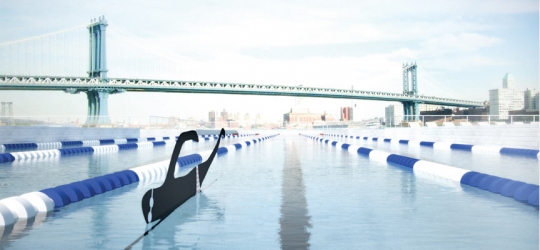
+pool vision. Source: pluspool.org
Marco and the rest of us are now devoting a significant amount ot time to planning HDL2012. More on this when we can, obviously.
Bryan, Kali (aka our colleague Karoliina Auvinen) and I are off to Berlin in a couple of weeks, on Brickstarter research. We're going to chat with Dieter Genske, who I had talk at Arup Melbourne last year, as we're particularly interested in small-scale community-owned energy infrastructure. But we'd also be interested in suggestions as to who else we should talk to while we're there (the background to Brickstarter is here and here; any relevant projects or people we should see in Berlin? Let us know via the comment box below, or tweet via @hdl2010)

Any mention of Berlin necessitates a still from Wings of Desire
Also, a new arrival! Our newest intern Kalle Freese started last week. Kalle's a student at the University of Helsinki, and also one of the best baristas in the Nordic Region, contributing to several of the best local food culture (and of course coffee culture) blogs, as well as working the local Helsinki scene.
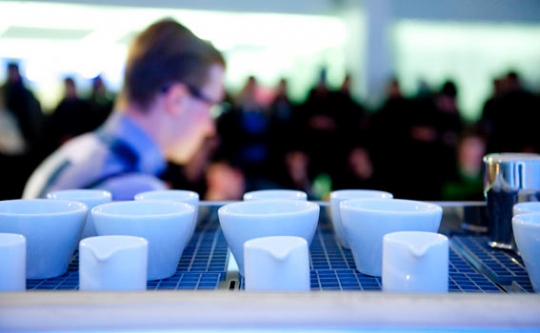
Kalle Freese. Source: nordiccoffeeculture.com
We'll get him to introduce himself here shortly, but you could read his bio at Nordic Coffee Culture in the meantime. While you're there, have a read of Kalle's write-up of his experience in the Finnish barista championships. What's good is the wider sense of how to talk about 'qualities', as well as the broader ideas of practice, service, environment, experience design, and so on.
Kalle will be working us on all projects, but primarily on the food work going on at Tukkutori, in Kalasatama. As with many, he understands and enjoys coffee because of an Antipodean experience, in his case New Zealand. It's a place that, I and many others would argue, possesses the world's best coffee culture (and this is nothing to do with my ongoing search for a good #helsinkiflatwhite, which those who follow my twitter account have to endure.)
I caught up with our Design Exchange placement #1, Sara Ikävalko, on Friday morning. She's got some great video footage of sketching sessions with high school students and others, which we'll get online shortly, and has been running workshops with seniors too; she is busy busy busy.
We rounded off the week in fine style with a great visit from Rodrigo Araya of Tironi Asociadios, in Chile. We were talking to Rodrigo for Brickstarter, and I've typed up the notes from the meeting over at the Brickstarter project blog. Rodrigo came highly recommended by my Arup colleague Alejandro Gutierrez.
Accompanied by my colleagues Karo Luoto, Kali Auvinen and Johanna Kirkinen, we spent a few hours picking Rodrigo's brains. Suffice to say, the projects in Constitución and Calama that Tironi are working on (with Alejandro Aravena as well as Gutierrez) are thoroughly inspiring, and exemplary models for citizen participation. Read more at Brickstarter; in terms of decision-making cultures, it's an invaluable case study.
Finally, it feels like Helsinki World Design Capital is beginning to really emerge now, just as the city emerges from winter. The snow has melted, the sun is shining, there's a Demos-fuelled pavilion latent with potential being built around the corner, and there are a slew of events, publications, projects, and happenings occurring now, which we hope will continue into the summer and beyond. One such publciation incldues 'Helsinki: Beyond Dreams' which Bryan contributed a piece to (you can read it here.)

Illustraton from Helsinki Beyond Dreams by Pent Talvet.
"A generation from now, will Helsinki and Tallinn be connected as a twin city filled with local urbane industries: small factories, craft workshops, courtyard cafes and scientific research labs flourishing side by side in the city centre?"
It's a lovely, lyrical piece building on our shared interest in small-scale manufacturing returning to city streets (and in doing so, finally making use of Helsinki's woefully-underused near-perfect courtyards). Incidentally, The Economist newspaper wrote in a very different mode about the same possibilities just this week, in their special report on 'A third industrial revolution'.

Illustration from The Economist's special report on manufacturing.
Finally, this week's how-to. In fact, a few of them. (As people that grew up with 'View source', we love a good how-to.)
The first, from pioneering coding community Rails Girls, is really nice example of a "how-to" for a good event. Top notch legibility.
Secondly, "Start-up tips from the food truck revolution" is more of an intervew than a how-to, formally, but you get to the same place.
Thirdly, the excellent new Neighborland has some great pointers for how to use their service to get things done in your (US-based) community. They seem so straightforward and common-sensical at first glance, but that's because the folks behind Neighborland are smart.
Finally, and probably-not-that-transferably, have a flick through the 'handbook for new employees' from games company Valve [PDF]. In a world of The Starfish and the Spider, these guys are clearly no fans of arachnids.
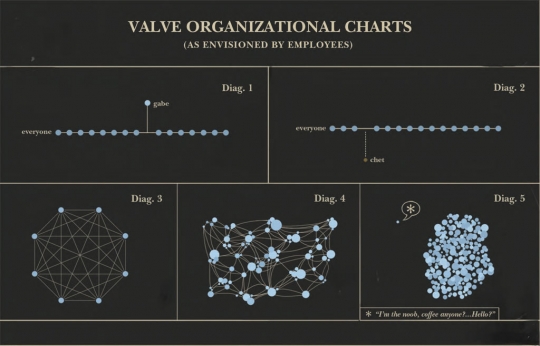
Org charts by Valve employees. Source: Valvesoftware.com
Adam Curtis teaches us to be wary of claims of self-organising communities — quite rightly in my view — but it's often instructive to observe the artefacts of those that try. You might compare and contrast with Forbes earlier this week; turns out there is an 'I' in team after all.
Always with the latenote.
OK, last week was busy. Bryan and I met with the City of Helsinki's Chief Information Officer Markku Raito RE Brickstarter. It was a good, engaged conversation; I'd met Markku in Oslo in December, at the Cisco Public Services Summit (funnily enough, we shared a taxi from the airport into Oslo, purely by chance, before realising we had a few things in common, not least our hometown. This shows there is actually some value to conferences.)
The City is exploring new avenues for citizen engagement in a few different areas, apparently including some variation on the 'local mayors' idea floated in the 'Clues' cards that Bryan et al helped put together.
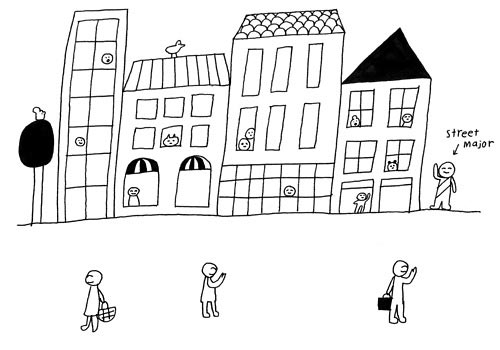
'Street mayor' idea from 'Clues to Open Helsinki'
But the real Mayor, Jussi Pajunen, took to Facebook and Twitter on Monday night to discuss the proposals for a Helsinki branch of the Guggenheim (which I think it's fair to say are 'controversial'). Interesting.
There was also a rather less-considered (in our view) experiment going on , involving people somewhat randomly hammering a touchscreen on a few streets, with little or no context, no comeback or personal responsibility, no attempt to reach a wider population, certainly no deliberation, and no clear idea on what will happen to the votes. Of course, this got significant publicity. Sigh.
(Incidentally, as the Sanomat newspaper points out, this could be third time lucky for the Katajanokka site and has a view on the delaying of the decision-making.)
Back in-house, Marco and I attended one of our internal workshops on Sitra's strategy, focused on the economy. It was good to see a lot of existing work and ongoing conversations on crowdfunding, as part of a 'diversifying sources of funding' discussion within the workshop. The 'Crowdfund' bill going through in the US recently is an interesting development.
More internal work: our plans for our 12th floor renovation - actually prototyping new ways of working, using the renovation of the floor as a lever - are coming to fruition, thanks to sterling work from architects KOKO3. We had a great session with Sitra staff on Thursday, in the traditional weekly get-together of 'torstai pulla' ('Thursday Bun!'). As Bryan noted last week, we've been working on this for a while, and liaising with lots of key people within our organisation, but it was fantastic to see so many Sitra staff actively interested and engaged at this more open session. (And the keener-eyed among you will note why we need to change this floor!)
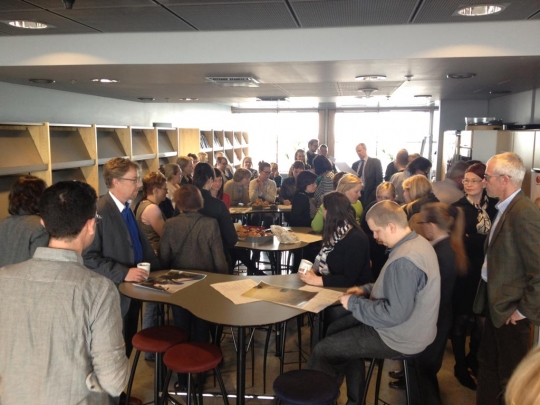
Thursday Bun session discussing plans for 12th floor
The new position in our Design Exchange programme remains open, by the way. Once again, we're looking for a designer to work with Helsinki Department of Social Services for a year (employed by them, working with them, and 'mentored' by us.) It's a great opportunity, so do apply if you're interested.
Speaking of design embedded in public service, this short interview with Head of Design for the UK's Government Digital Services, Ben Terrett, is worth a read too. Their output is shaping up wonderfully, but the broader point about design (and other things) addressing meaningful problems and major challenges, and in doing so making peoples' lives better, is an extremely important side-effect of doing quality work in government.
Thursday, Bryan and I spent the day amidst the slowly de-ruining ruins of Kalasatama - at the Tukkutori market development, specifically - for another all-day workshop continuing the work with Antto Melasniemi, Elina Forss and Ville Relander (noted here previously). All going well, and we're getting close to 'de-cloaking' this project; you can tell that, as we're knee-deep in conversations about the name (ugh).
By the way, I wrote a short piece about street food and urbanism, via Ravintolapäivä, as part of "Manifest", a new magazine put together by Artek and others, for World Design Capital. It's available in Artek stores, across the city, and at the Salone design fair in Milan, which is going on this week. There are Finnish and English editions, and contributions from a good set of writers. (Nice to see my words in Finnish, actually, even though I have no idea if they're the right ones. It's nicely designed by top local firm TSTO too. Well worth picking up if you're in town.) This is part of our ongoing background research around the aforementioned food projects.
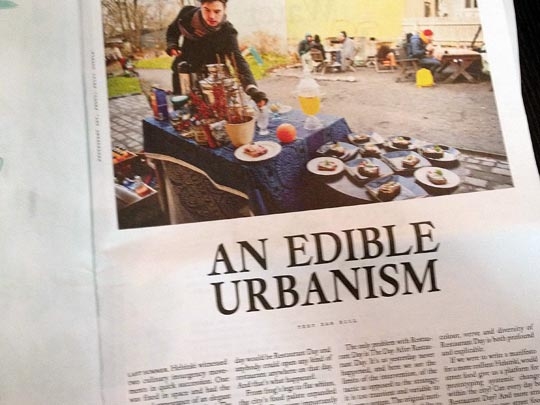
On Friday, I had the pleasure of meeting people from the Strelka Institute for Media, Architecture and Design in Moscow. Strelka is a fantastically interesting intervention into the city - Rem Koolhaas's firm AMO have been involved in the curriculum - and hopefully there's something interesting brewing between us and them.
And we've started getting seriously into planning our next HDL event. It's been a bit of a 'phoney war' up until now, but now we are into dates, venues, formats and participants. Exciting.
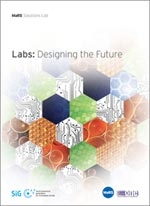
I've also been liaising with Social Innovation Generation and MaRS Discovery District, in Toronto, Ontario, including some interesting exploratory conversations around design labs for social innovation. Lisa Torjman of MaRS wrote an excellent report on the labs concept, drawing from the likes of Mindlab, IDEO, Participle and us. Lisa's report does a great job of setting the scene in particular, as well as expertly nailing the case studies. It's well worth a read. That is an emerging discussion, but heading somewhere very interesting.
We also note with interest John Thackara's extremely useful and thought-provoking set of 'handouts' around particular themes, or challenges. (John's twitter feed is always usefully thought-provoking, too, by the way.)
Finally, and predictably, we've all been drawn in by the second season of DR's majestic political drama 'Borgen'. Such is the way of on-demand media, team members have now each watched an entirely different number of episodes, so any detailed conversations about the plot is verboten (or 'forbudt', perhaps.) Suffice to say, Birgitte Nyborg would ideally be the Statsminister of everywhere.
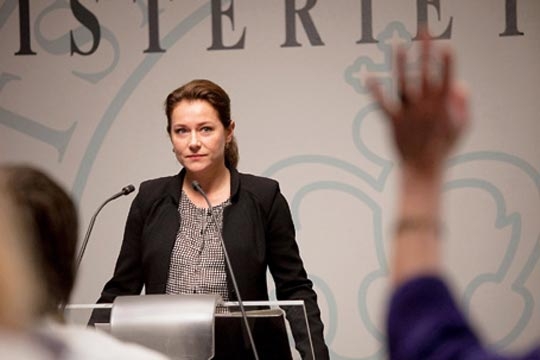
Birgitte Nyborg, Statsminister
